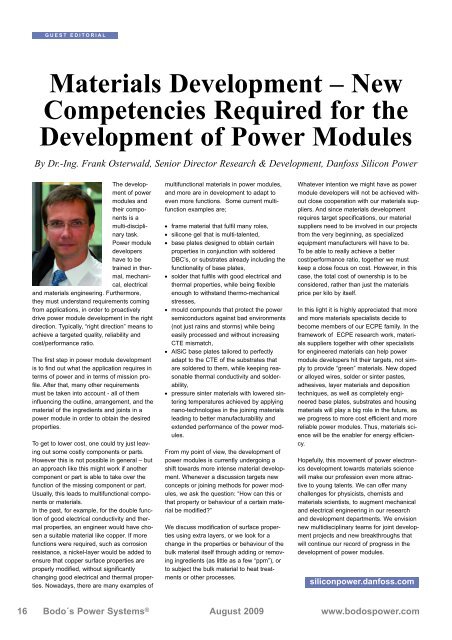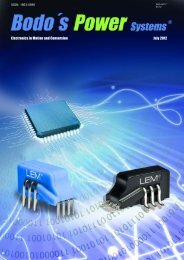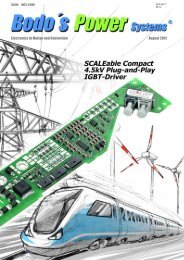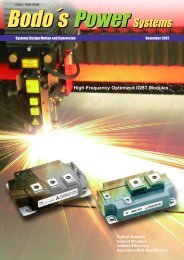Features - Bodo's Power
Features - Bodo's Power
Features - Bodo's Power
Create successful ePaper yourself
Turn your PDF publications into a flip-book with our unique Google optimized e-Paper software.
GUEST EDITORIAL<br />
Materials Development – New<br />
Competencies Required for the<br />
Development of <strong>Power</strong> Modules<br />
By Dr.-Ing. Frank Osterwald, Senior Director Research & Development, Danfoss Silicon <strong>Power</strong><br />
The development<br />
of power<br />
modules and<br />
their components<br />
is a<br />
multi-disciplinary<br />
task.<br />
<strong>Power</strong> module<br />
developers<br />
have to be<br />
trained in thermal,mechanical,<br />
electrical<br />
and materials engineering. Furthermore,<br />
they must understand requirements coming<br />
from applications, in order to proactively<br />
drive power module development in the right<br />
direction. Typically, “right direction” means to<br />
achieve a targeted quality, reliability and<br />
cost/performance ratio.<br />
The first step in power module development<br />
is to find out what the application requires in<br />
terms of power and in terms of mission profile.<br />
After that, many other requirements<br />
must be taken into account - all of them<br />
influencing the outline, arrangement, and the<br />
material of the ingredients and joints in a<br />
power module in order to obtain the desired<br />
properties.<br />
To get to lower cost, one could try just leaving<br />
out some costly components or parts.<br />
However this is not possible in general – but<br />
an approach like this might work if another<br />
component or part is able to take over the<br />
function of the missing component or part.<br />
Usually, this leads to multifunctional components<br />
or materials.<br />
In the past, for example, for the double function<br />
of good electrical conductivity and thermal<br />
properties, an engineer would have chosen<br />
a suitable material like copper. If more<br />
functions were required, such as corrosion<br />
resistance, a nickel-layer would be added to<br />
ensure that copper surface properties are<br />
properly modified, without significantly<br />
changing good electrical and thermal properties.<br />
Nowadays, there are many examples of<br />
multifunctional materials in power modules,<br />
and more are in development to adapt to<br />
even more functions. Some current multifunction<br />
examples are;<br />
• frame material that fulfil many roles,<br />
• silicone gel that is multi-talented,<br />
• base plates designed to obtain certain<br />
properties in conjunction with soldered<br />
DBC’s, or substrates already including the<br />
functionality of base plates,<br />
• solder that fulfils with good electrical and<br />
thermal properties, while being flexible<br />
enough to withstand thermo-mechanical<br />
stresses,<br />
• mould compounds that protect the power<br />
semiconductors against bad environments<br />
(not just rains and storms) while being<br />
easily processed and without increasing<br />
CTE mismatch,<br />
• AlSiC base plates tailored to perfectly<br />
adapt to the CTE of the substrates that<br />
are soldered to them, while keeping reasonable<br />
thermal conductivity and solderability,<br />
• pressure sinter materials with lowered sintering<br />
temperatures achieved by applying<br />
nano-technologies in the joining materials<br />
leading to better manufacturability and<br />
extended performance of the power modules.<br />
From my point of view, the development of<br />
power modules is currently undergoing a<br />
shift towards more intense material development.<br />
Whenever a discussion targets new<br />
concepts or joining methods for power modules,<br />
we ask the question: “How can this or<br />
that property or behaviour of a certain material<br />
be modified?”<br />
We discuss modification of surface properties<br />
using extra layers, or we look for a<br />
change in the properties or behaviour of the<br />
bulk material itself through adding or removing<br />
ingredients (as little as a few “ppm”), or<br />
to subject the bulk material to heat treatments<br />
or other processes.<br />
Whatever intention we might have as power<br />
module developers will not be achieved without<br />
close cooperation with our materials suppliers.<br />
And since materials development<br />
requires target specifications, our material<br />
suppliers need to be involved in our projects<br />
from the very beginning, as specialized<br />
equipment manufacturers will have to be.<br />
To be able to really achieve a better<br />
cost/performance ratio, together we must<br />
keep a close focus on cost. However, in this<br />
case, the total cost of ownership is to be<br />
considered, rather than just the materials<br />
price per kilo by itself.<br />
In this light it is highly appreciated that more<br />
and more materials specialists decide to<br />
become members of our ECPE family. In the<br />
framework of ECPE research work, materials<br />
suppliers together with other specialists<br />
for engineered materials can help power<br />
module developers hit their targets, not simply<br />
to provide “green” materials. New doped<br />
or alloyed wires, solder or sinter pastes,<br />
adhesives, layer materials and deposition<br />
techniques, as well as completely engineered<br />
base plates, substrates and housing<br />
materials will play a big role in the future, as<br />
we progress to more cost efficient and more<br />
reliable power modules. Thus, materials science<br />
will be the enabler for energy efficiency.<br />
Hopefully, this movement of power electronics<br />
development towards materials science<br />
will make our profession even more attractive<br />
to young talents. We can offer many<br />
challenges for physicists, chemists and<br />
materials scientists, to augment mechanical<br />
and electrical engineering in our research<br />
and development departments. We envision<br />
new multidisciplinary teams for joint development<br />
projects and new breakthroughs that<br />
will continue our record of progress in the<br />
development of power modules.<br />
siliconpower.danfoss.com<br />
16 Bodo´s <strong>Power</strong> Systems ® August 2009 www.bodospower.com







